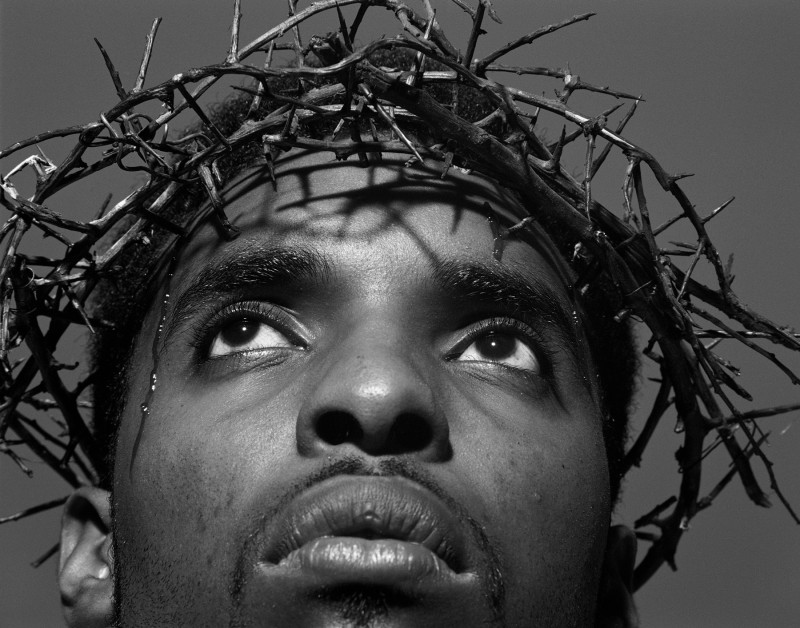
Pigmented inkjet print
45 x 57 in
Edition of 8
Born in London in 1969, Faisal Abdu’Allah is a British artist whose work primarily evolves from the interface of photography, the printed image and lens-based installation. He constantly repositions values and ideologies pertaining to representation. Abdu’Allah is a senior lecturer in Fine Art at the University of East London. He lives and maintains a studio in London.
– Artist’s website
* * *
The Revelations series [is] a continuation of the creative partnership between Abdu’Allah and Kofi Allen that had begun with The Last Supper. Shot from close, oblique angles, Revelations foregrounds those final moments of Christ’s ultimate suffering during the Crucifixion using high definition, monochrome photography to capture the intricate texture of skin, the viscosity of bodily fluid and the radiance of divine light. In one image a crown of thorns pierces the forehead, in another the stigmata in the palm of a creased hand oozes a trickle of blood and another features an Egyptian ankh, the sacred symbol of life that pre-dates the crucifix, which reinforces Abdu’Allah’s spiritual connection to Nubian civilization.
The series manifests an interest in the power of ritual gestures: the specific position of hands and arms to protect the body, to confess the faith and invoke divine presence. The position of the camera, the lens pointing dramatically upward to enhance a sense of sacred elevation further enables such gestures to act as framing devices, capturing the face and crown of thorns as a definitive image of Christian sacrifice and salvation.
The deployment of the camera in Revelations reflects Abdu’Allah’s wider interest in the physical relationship of the viewer’s gaze to his work. The sharp, ascending angle of the lens contradicts the flatness of the photographic surface and conveys a dizzying sense of perspective in which the viewer experiences physical diminution. Details that are highlighted such as the signifiers of the anointed are in sharp focus whilst others such as the human face in silent stillness recede. As with The Last Supper, Abdu’Allah plays with the accepted iconography of Western Christianity and the canon of religious art but contests the authority of a solely blonde-haired blue-eyed Christ. For Abdu’Allah, divinity can transcend skin or hair color, and thereby, preconceived notions of being authorized by one race only. Unlike the simultaneous confrontation and defensiveness deployed within The Last Supper, any attempt at eye contact or front-on scrutiny is frustrated within this work. We are restricted to a mortal viewpoint, powerlessly gazing up at a man depicted as Jesus Christ, savior, prophet and icon.
– Rachel Newman in “The Art of Dislocation,” p. 41; OrbisAfrica Graphic Writing Systems lab and the Stanford Department of Art and Art History, CA, 2010
show prices
Prices and availability are subject to change without notice.The copyright of all art images belongs to the individual artists and Magnolia Editions, Inc.
©2003-2025 Magnolia Editions, Inc. All rights reserved. contact us
